Aerodynamic Analysis of Fixed-Wing Unmanned Aerial Vehicles Moving in Swarm
Abstract
:1. Introduction
2. Materials and Methods
2.1. Geometry
2.2. Meshing
2.3. Governing Equations
2.4. Validation
2.5. Aerodynamic Analysis of Single UAV
3. Aerodynamic Analysis of the Close-Formation Flight for Two UAVs
3.1. Formation Sequences
3.2. Mesh Independence
4. Results and Discussion
5. Conclusions
- (1)
- The characteristics in the aerodynamic interaction region of the longitudinal distance behind the UAV do not change greatly.
- (2)
- Two UAVs flying in close formation should avoid flying inside the wing line to avoid entering the downwash area, as this can have a negative interaction.
- (3)
- For the most efficient aerodynamic performance in close flight of swarm UAVs, they must fly at the same altitude, i.e., in the same vertical alignment.
- (4)
- For b wingspan, the most aerodynamically efficient spots for close-formation flight are lateral distances of 0.875b and 1b.
- (5)
- Considering CL/CD as an aerodynamic performance parameter, in the most efficient flight positions, the trailing UAV has an efficiency increase of about 11.5% compared to a single flight.
Author Contributions
Funding
Data Availability Statement
Acknowledgments
Conflicts of Interest
References
- Shao, Z.; Yan, F.; Zhou, Z.; Zhu, X. Path planning for multi-UAV formation Rendezvous based on distributed cooperative particle swarm optimization. Appl. Sci. 2019, 9, 2621. [Google Scholar] [CrossRef]
- Wieselsberger, C. Beitrag zur erklärung des winkelfluges einiger zugvöge. Z. FlugTechnick Mot. 1914, 5, 225–229. [Google Scholar]
- Lissaman, P.B.S.; Schollenberger, C.A. Formation flight of birds. Science 1970, 168, 1003–1005. [Google Scholar] [CrossRef] [PubMed]
- Hansen, J.L.; Cobleigh, B.R. Induced moment effects of formation flight using two F/A-18 aircraft. In Proceedings of the AIAA Atmospheric Flight Mechanics Conference and Exhibit, Monterey, CA, USA, 5–8 August 2002. [Google Scholar]
- Pahle, J.; Berger, D.; Venti, M.; Duggan, C.; Faber, J.; Cardinal, K. An initial flight investigation of formation flight for drag reduction on the C-17 aircraft. In Proceedings of the AIAA Atmospheric Flight Mechanics Conference, Minneapolis, MN, USA, 13–16 August 2012. [Google Scholar]
- Dogan, A.; Venkataramanan, S.; Blake, W. Modeling of aerodynamic coupling between aircraft in close proximity. J. Aircr. 2005, 42, 941–955. [Google Scholar] [CrossRef]
- Singh, D.; Antoniadis, A.F.; Tsoutsanis, P.; Shin, H.; Tsourdos, A.; Mathekga, A.; Jenkins, K.W. A multi-fidelity approach for aerodynamic performance computations of formation flight. Aerospace 2018, 5, 66. [Google Scholar] [CrossRef]
- Yuan, G.; Xia, J.; Duan, H. A continuous modeling method via improved pigeon-inspired optimization for wake vortices in UAVs close formation flight. Aerosp. Sci. Technol. 2021, 120, 107259. [Google Scholar] [CrossRef]
- Blake, W.; Gingras, D.R. Comparison of predicted and measured formation flight interference effects. J. Aircr. 2004, 41, 201–207. [Google Scholar] [CrossRef]
- Trumic, E.; Swamy, K.S. Aerodynamic Performance Analysis of a UAV Using CFD and VLM. Master’s Thesis, Linköping University, Linköping, Sweden, 2021. [Google Scholar]
- Cui, X.; Yu, Y.; Ma, S.; Xiao, Z.; Zhang, L.; Liu, F. Numerical investigation of the aerodynamic interference in 2-aircraft formation flight. J. Phys. Conf. Ser. 2022, 2280, 012017. [Google Scholar] [CrossRef]
- Yang, T.; Zhiyong, L.; Neng, X.; Yan, S.; Jun, L. Optimization of positional parameters of close-formation flight for blended-wing-body configuration. Heliyon 2018, 4, e01019. [Google Scholar] [CrossRef] [PubMed]
- Zhang, D.; Chen, Y.; Dong, X.; Liu, Z.; Zhou, Y. Numerical aerodynamic characteristics analysis of the close formation flight. Math. Probl. Eng. 2018, 2018, 3136519. [Google Scholar] [CrossRef]
- Shin, H.; Antoniadis, A.F.; Tsourdos, A. Parametric study on efficient formation flying for a blended-wing UAV. In Proceedings of the 2017 International Conference on Unmanned Aircraft Systems (ICUAS), Miami, FL, USA, 13–16 June 2017. [Google Scholar]
- Panagiotou, P.; Yakinthos, K. Aerodynamic efficiency and performance enhancement of fixed-wing UAVs. Aerosp. Sci. Technol. 2019, 99, 105575. [Google Scholar] [CrossRef]
- Shunshun, W.; Zheng, G. Design, optimization and application of two-element airfoils for tactical UAV. Adv. Mech. Eng. 2022, 14, 1–14. [Google Scholar] [CrossRef]
- Pastor, L.G.S. Numerical Design and Optimization of a Rescue UAV’s Wing. Bachelor’s Thesis, Universitat Politècnica de València, Valencia, Spain, 2022. [Google Scholar]
- Arabacı, S.K.; Dilbaz, F. Aerodynamic Analysis of Anka UAV and Heron UAV. In Proceedings of the 2nd International Conference on Energy Research, Marmaris, Turkey, 11–13 April 2019. [Google Scholar]
- Zore, K.; Sasanapuri, B.; Parkhi, G.; Varghese, A. ANSYS mosaic poly-hexcore mesh for high-lift aircraft configuration. In Proceedings of the 21st Annual CFD Symposium, Bangalore, India, 8–9 August 2019. [Google Scholar]
- Pezzella, G.; Viviani, A. Aerodynamic Performance Analysis of Three Different Unmanned Re-entry Vehicles. In Advanced UAV Aerodynamics, Flight Stability and Control, 1st ed.; Marquès, P., Da Ronch, A., Eds.; Wiley: Hoboken, NJ, USA, 2017; pp. 49–141. [Google Scholar]
- Aydın, N.; Çalışkan, M.E.; Karagöz, İ. Numerical simulation of flow over NACA 0015 airfoil with different turbulence models. Int. J. Energy Appl. Technol. 2020, 7, 42–49. [Google Scholar] [CrossRef]
- Menter, F.R. Zonal two equation k-ω turbulence models for aerodynamic flows. In Proceedings of the 24th Fluid Dynamics Conference, Orlando, FL, USA, 6–9 July 1993. [Google Scholar]
- Jacobs, E.N.; Ward, K.E.; Pinkerton, R.M. The Characteristics of 78 Related Airfoil Sections from Tests in the Variable-Density Wind Tunnel; Report No. 460; National Advisory Committee for Aeronautics: Washington, DC, USA, 1935. [Google Scholar]
- Steenwijk, B.; Druetta, P. Numerical study of turbulent flows oner a NACA 0012 airfoil: Insights into its performance and the addition of a slotted flap. Appl. Sci. 2023, 17, 7890. [Google Scholar] [CrossRef]
- Çengel, Y.; Cimbala, J.M. Akışkanlar Mekaniği, 1st ed.; Güven Bilimsel: İzmir, Türkiye, 2008. [Google Scholar]
- Baykar. Available online: https://baykartech.com/tr/uav/bayraktar-tb2/ (accessed on 13 May 2024).
- Munk, M.M. The Minimum Induced Drag of Aerofoils; Report No. 121; National Advisory Committee for Aeronautics: Washington, DC, USA, 1923. [Google Scholar]

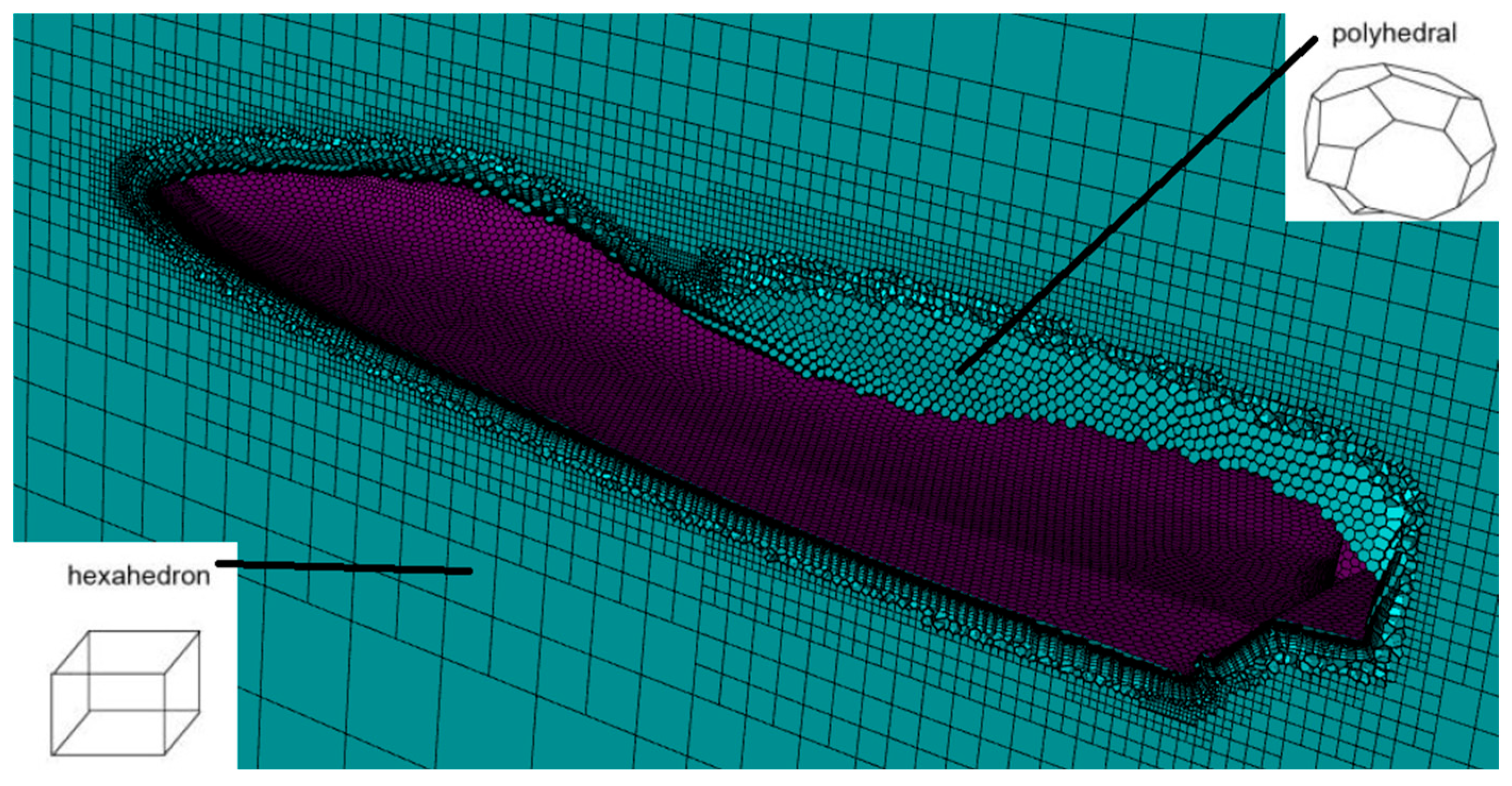
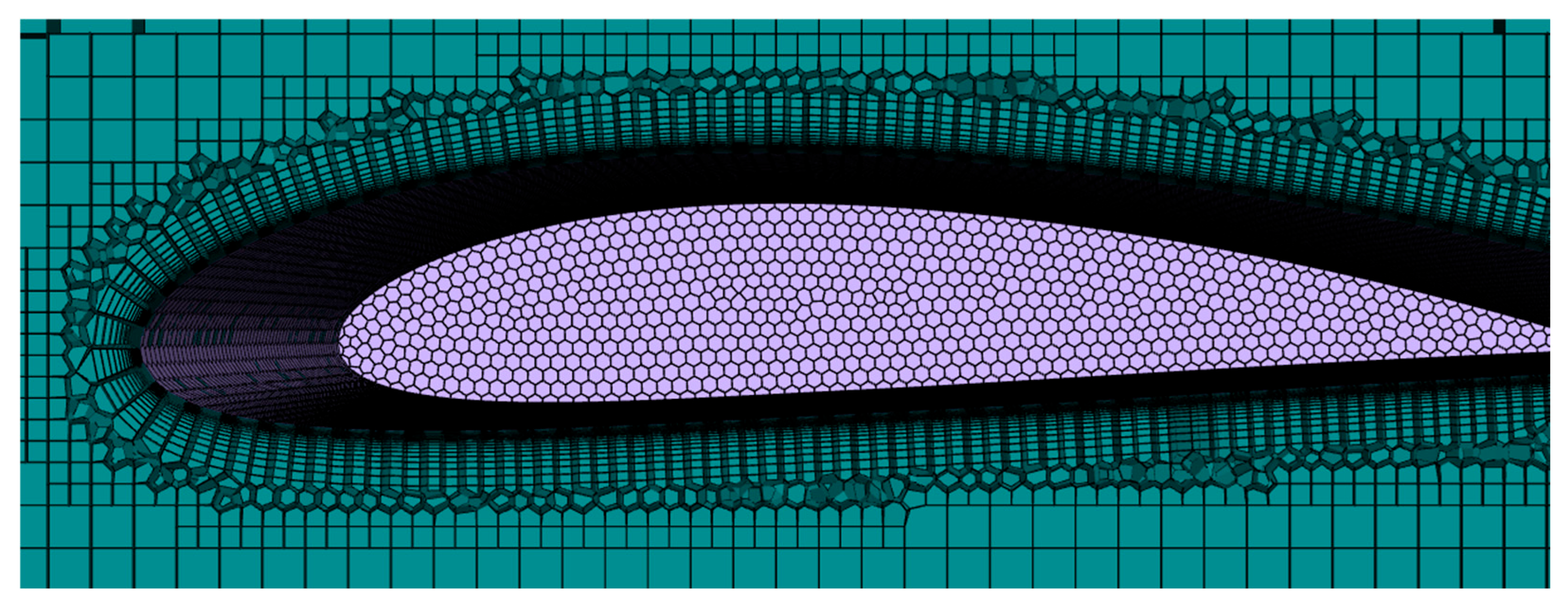
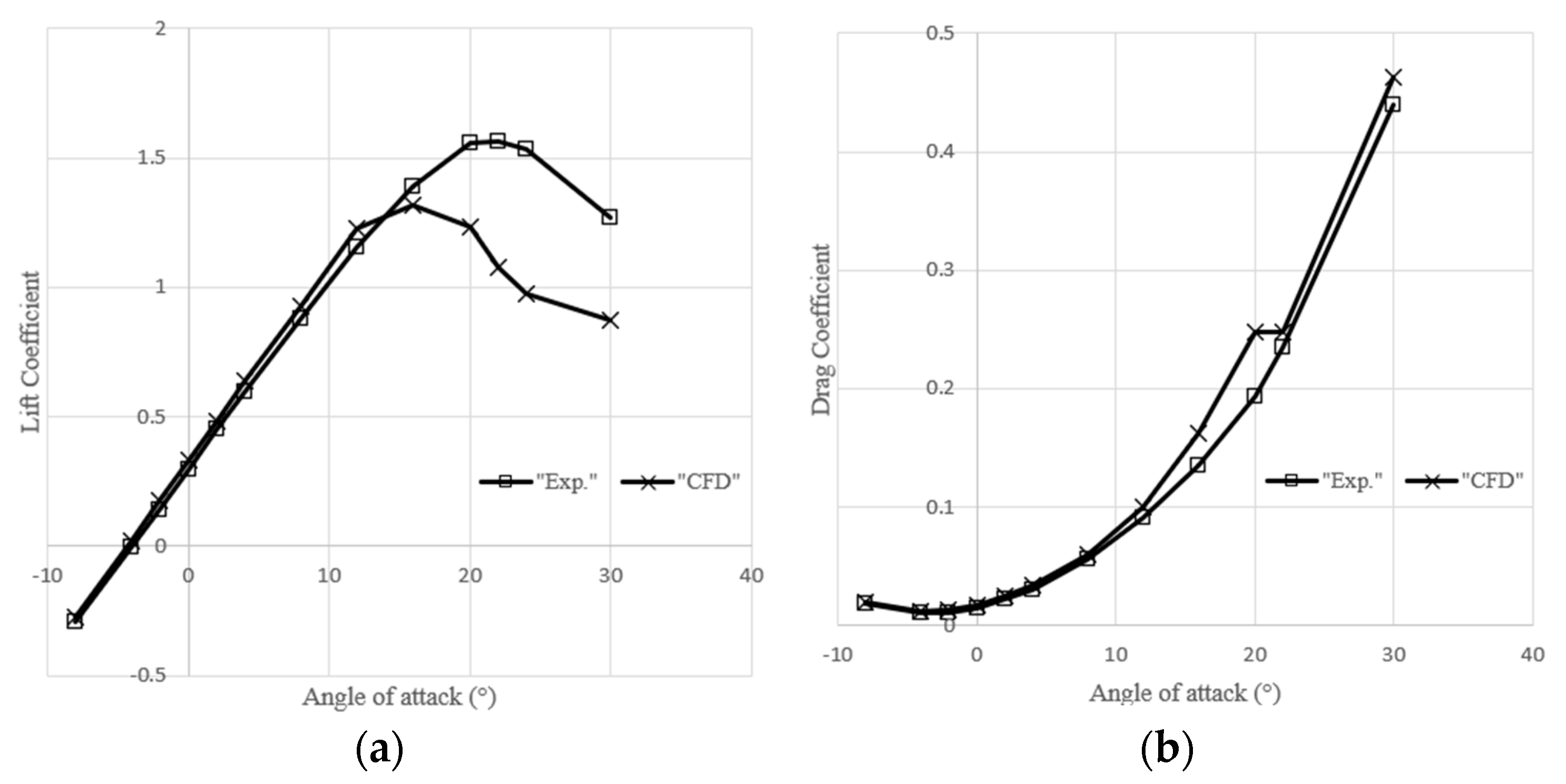

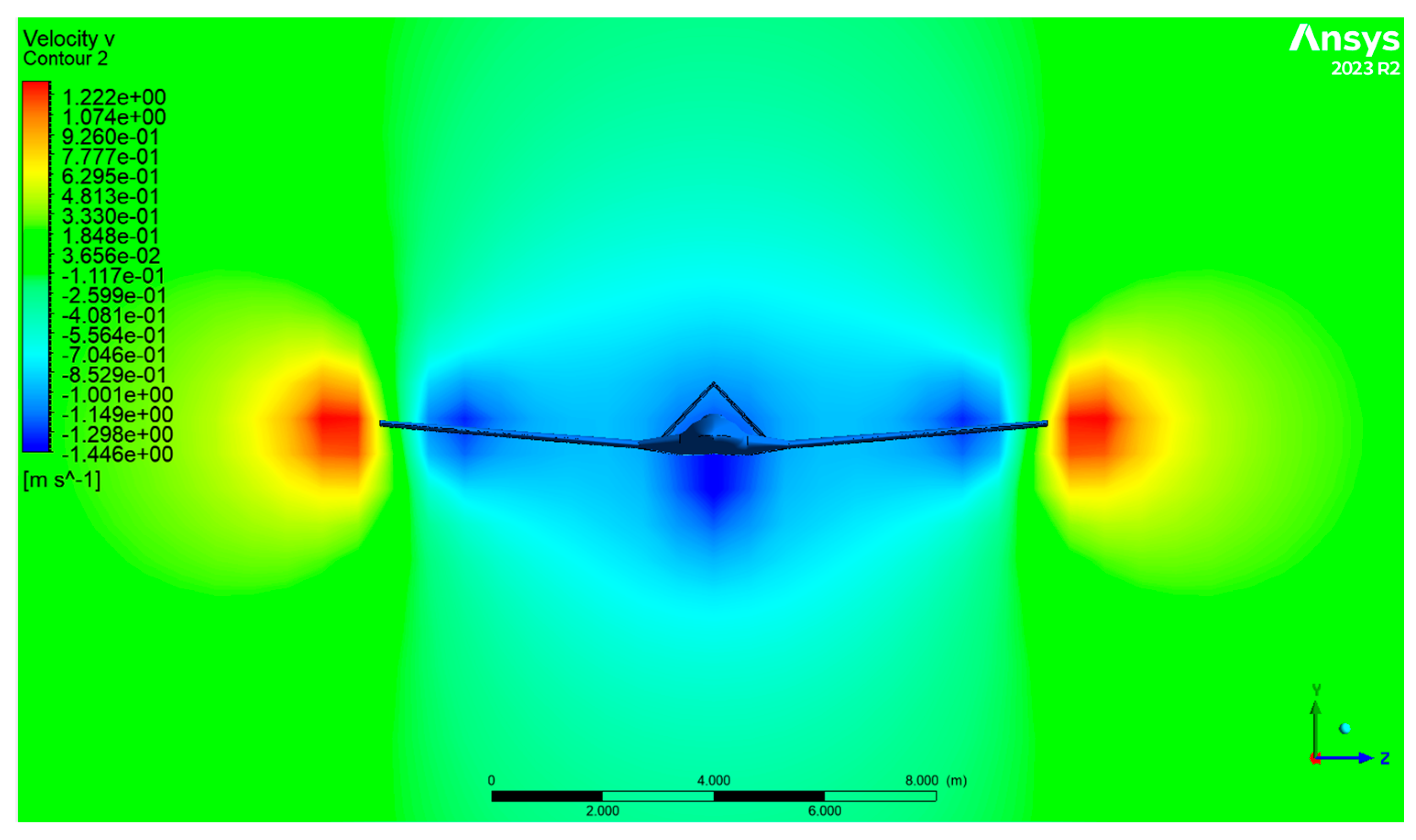
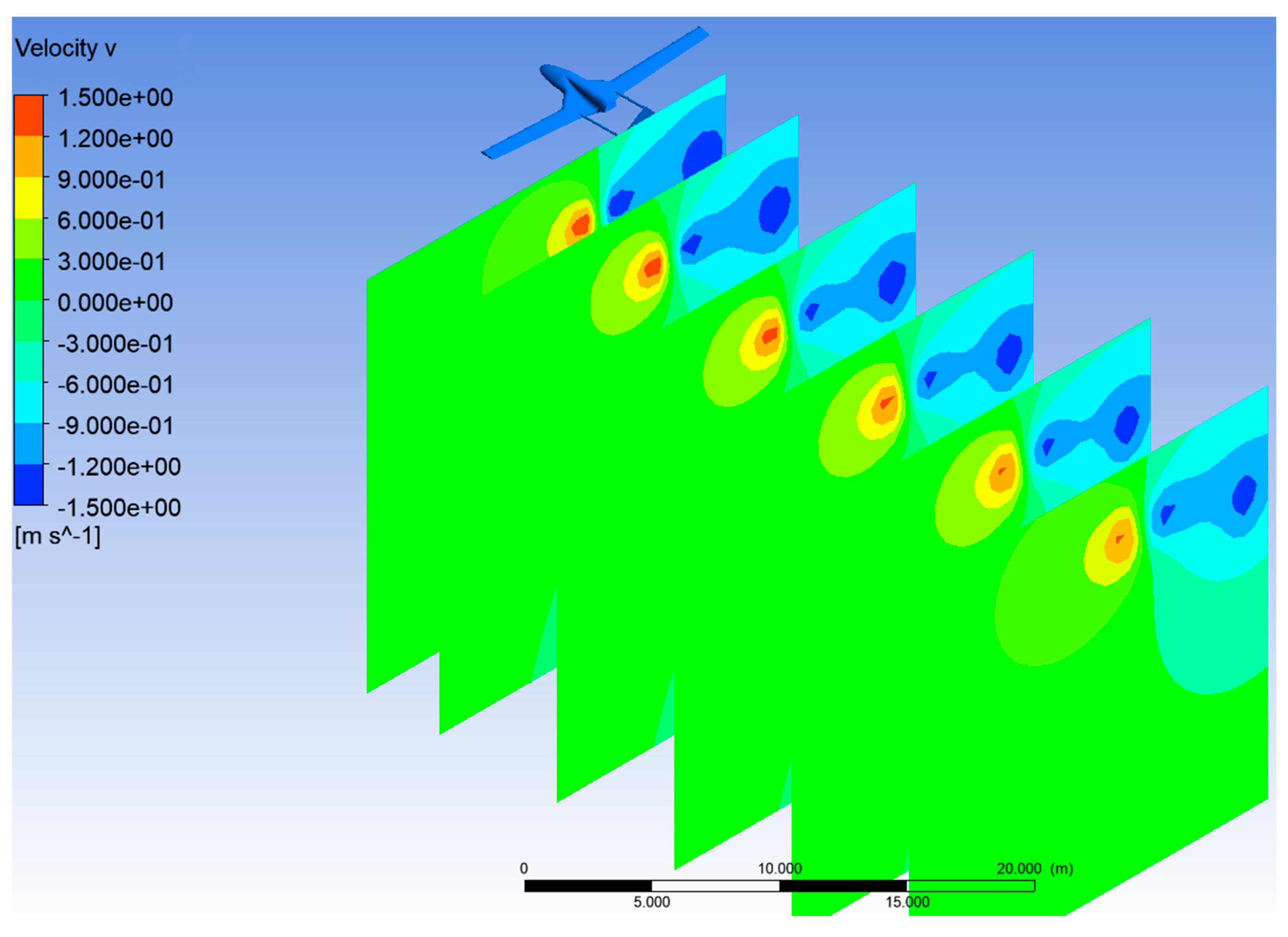

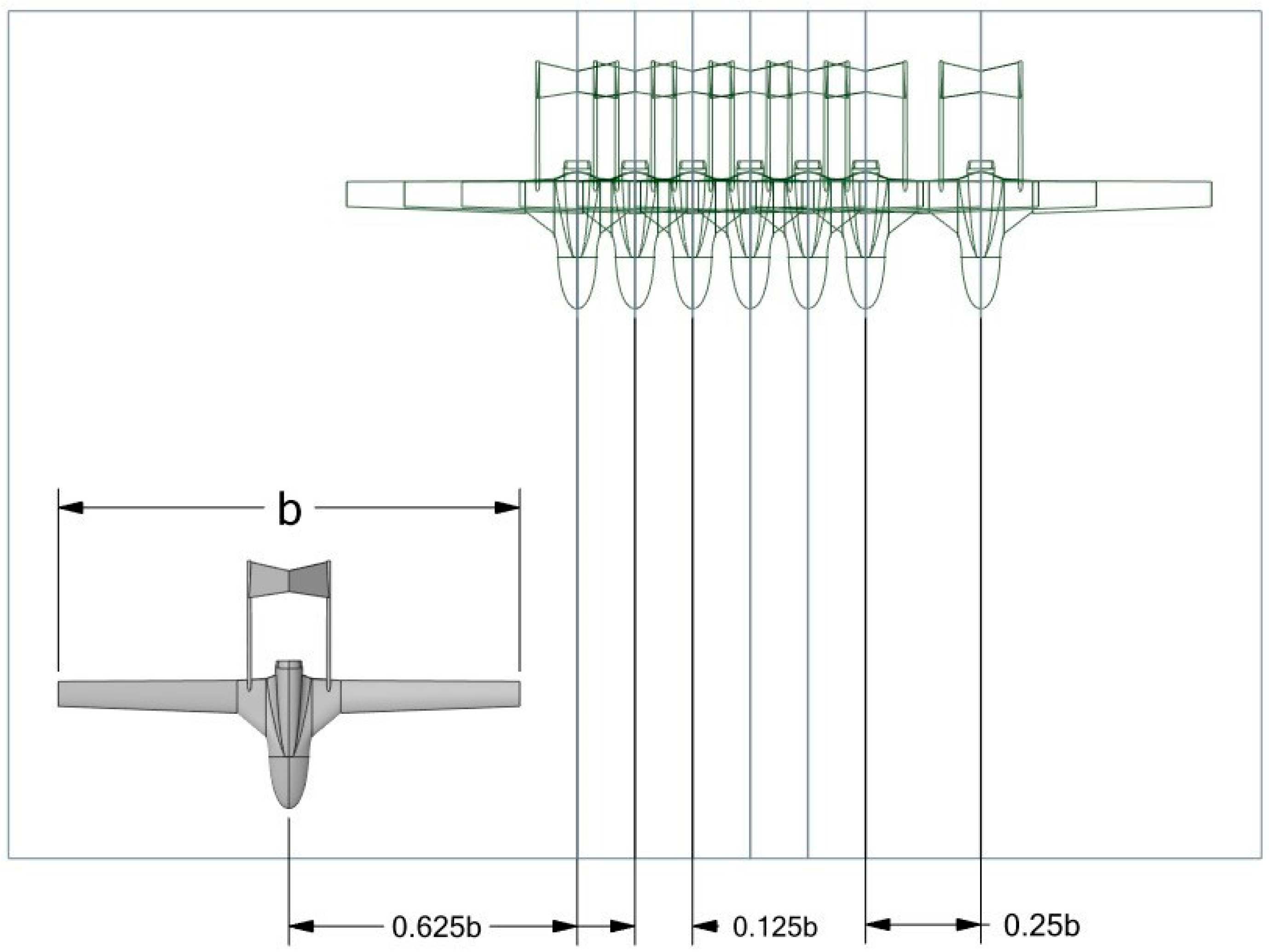

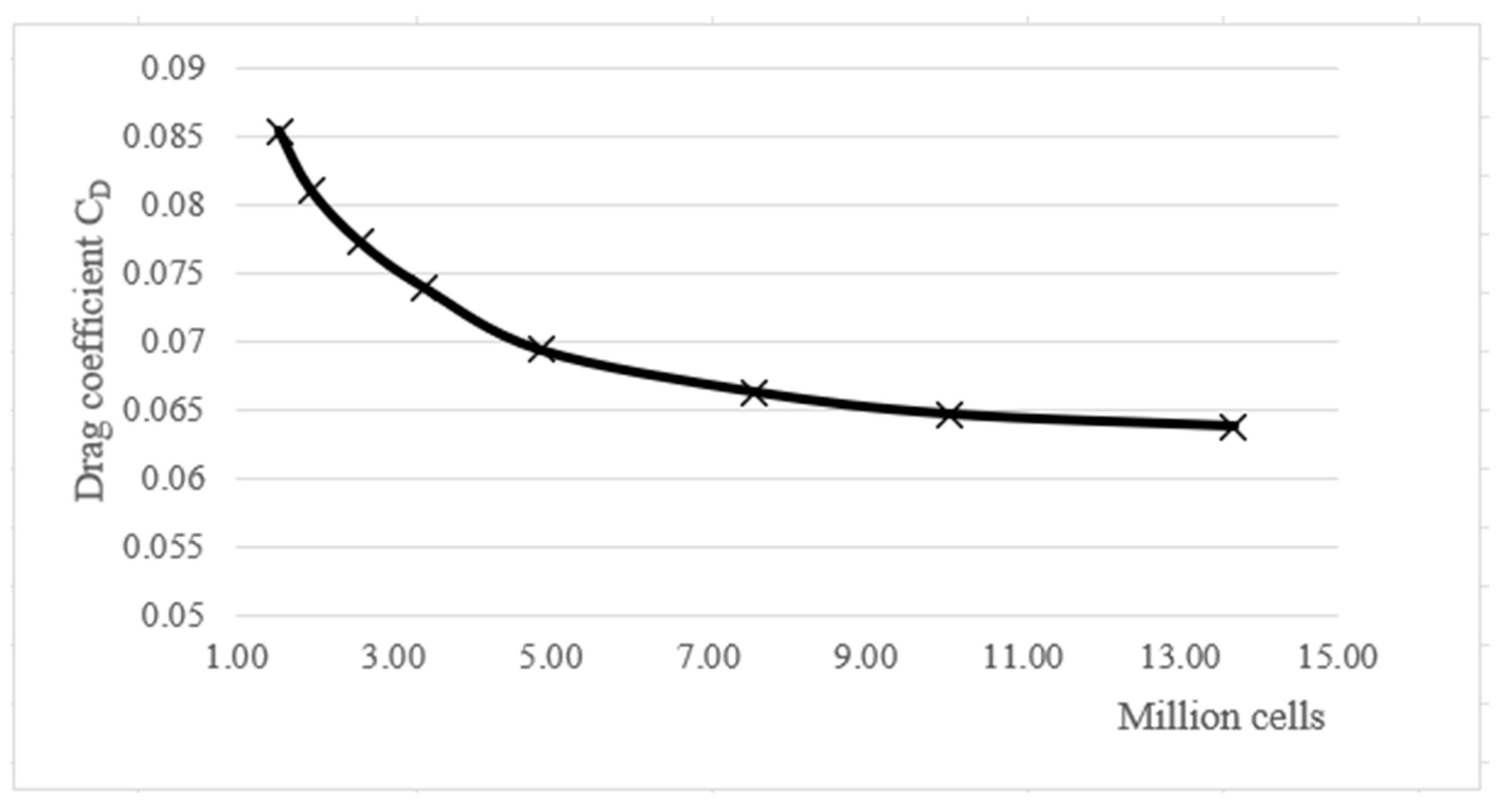

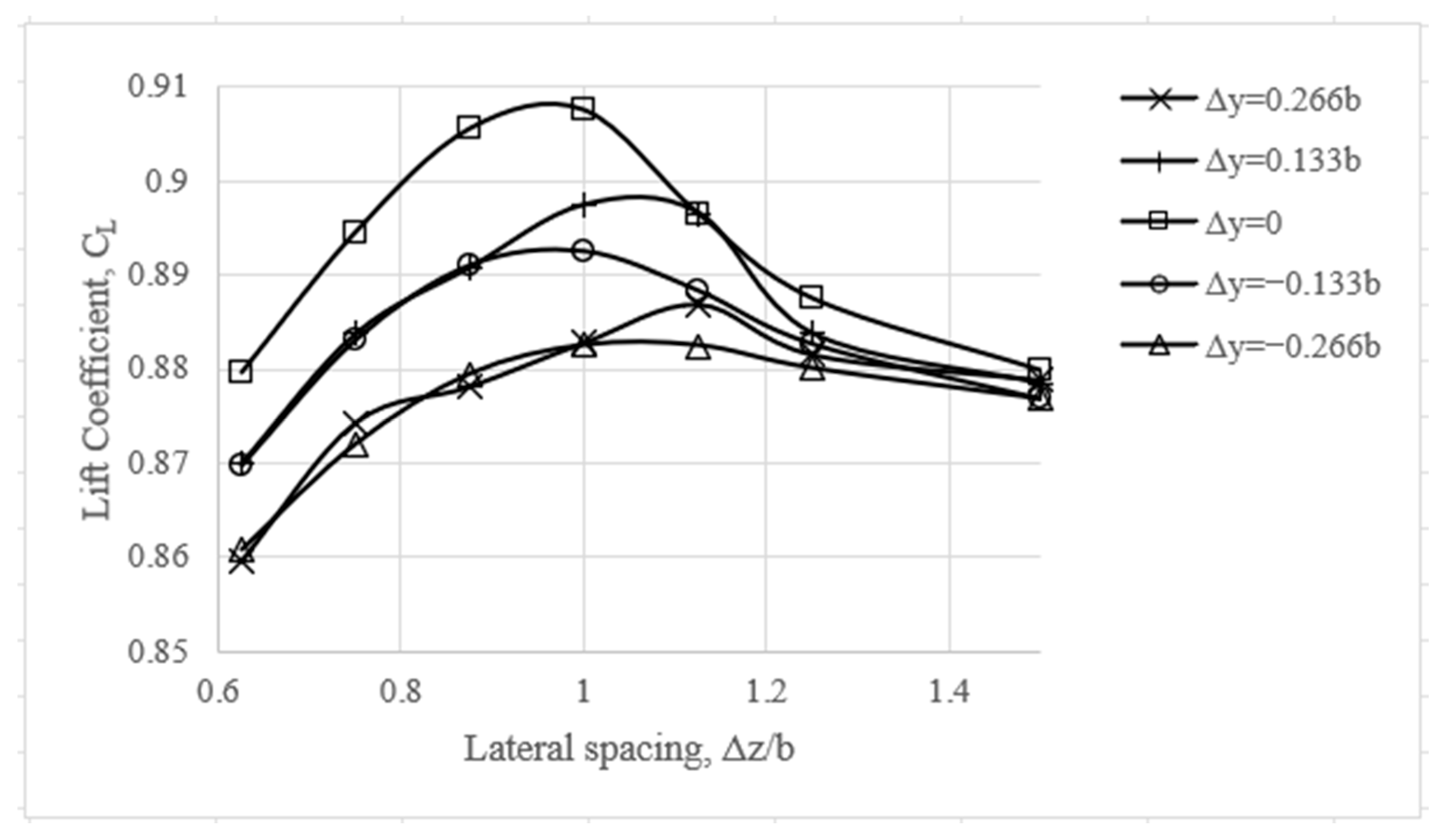
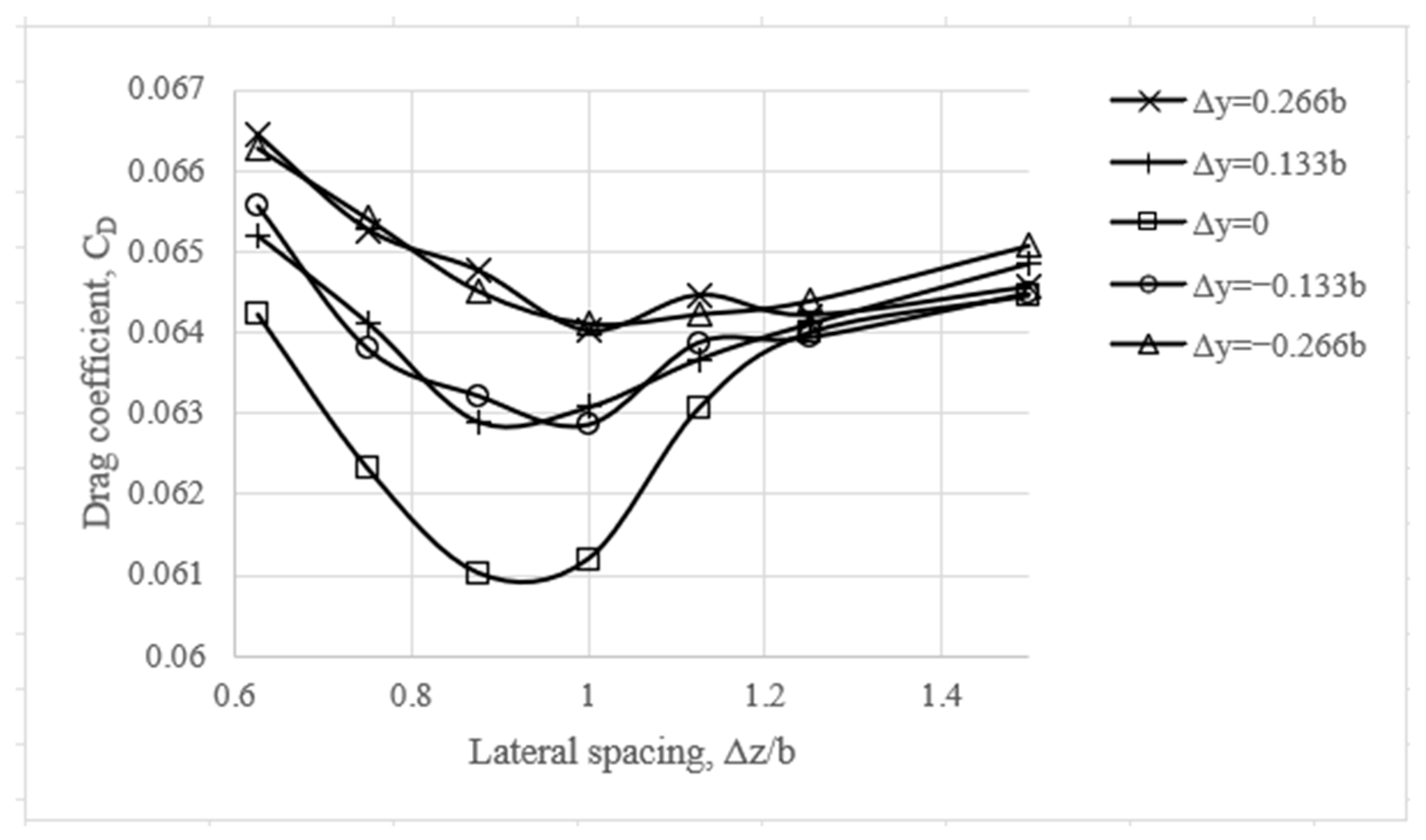


| Parameter | Value |
|---|---|
| Wingspan | 12 m |
| Length | 6.5 m |
| Chord length (mean) | 0.78 m |
| Height | 1.6 m |
| Area | 9.34 m2 |
| Parameter | Value |
|---|---|
| Altitude | 5500 m |
| Density | 0.6975 kg/m3 |
| Viscosity | 1.6115 × 10−5 kg/(m·s) |
| Velocity | 36.01 m/s |
| Re | 1,215,714.58 |
| ∆z | ∆y = 3.2 m | ∆y = 1.6 m | ∆y = 0 m | ∆y = −1.6 m | ∆y = −3.2 m |
|---|---|---|---|---|---|
| 18 m | Analysis 1 | Analysis 2 | Analysis 3 | Analysis 4 | Analysis 5 |
| 15 m | Analysis 6 | Analysis 7 | Analysis 8 | Analysis 9 | Analysis 10 |
| 12 m | Analysis 11 | Analysis 12 | Analysis 13 | Analysis 14 | Analysis 15 |
| 9 m | Analysis 16 | Analysis 17 | Analysis 18 | Analysis 19 | Analysis 20 |
| 10.5 m | Analysis 21 | Analysis 22 | Analysis 23 | Analysis 24 | Analysis 25 |
| 7.5 m | Analysis 26 | Analysis 27 | Analysis 28 | Analysis 29 | Analysis 30 |
| 13.5 m | Analysis 31 | Analysis 32 | Analysis 33 | Analysis 34 | Analysis 35 |
Disclaimer/Publisher’s Note: The statements, opinions and data contained in all publications are solely those of the individual author(s) and contributor(s) and not of MDPI and/or the editor(s). MDPI and/or the editor(s) disclaim responsibility for any injury to people or property resulting from any ideas, methods, instructions or products referred to in the content. |
© 2024 by the authors. Licensee MDPI, Basel, Switzerland. This article is an open access article distributed under the terms and conditions of the Creative Commons Attribution (CC BY) license (https://creativecommons.org/licenses/by/4.0/).
Share and Cite
İnan, A.T.; Ceylan, M. Aerodynamic Analysis of Fixed-Wing Unmanned Aerial Vehicles Moving in Swarm. Appl. Sci. 2024, 14, 6463. https://doi.org/10.3390/app14156463
İnan AT, Ceylan M. Aerodynamic Analysis of Fixed-Wing Unmanned Aerial Vehicles Moving in Swarm. Applied Sciences. 2024; 14(15):6463. https://doi.org/10.3390/app14156463
Chicago/Turabian Styleİnan, Ahmet Talat, and Mustafa Ceylan. 2024. "Aerodynamic Analysis of Fixed-Wing Unmanned Aerial Vehicles Moving in Swarm" Applied Sciences 14, no. 15: 6463. https://doi.org/10.3390/app14156463





